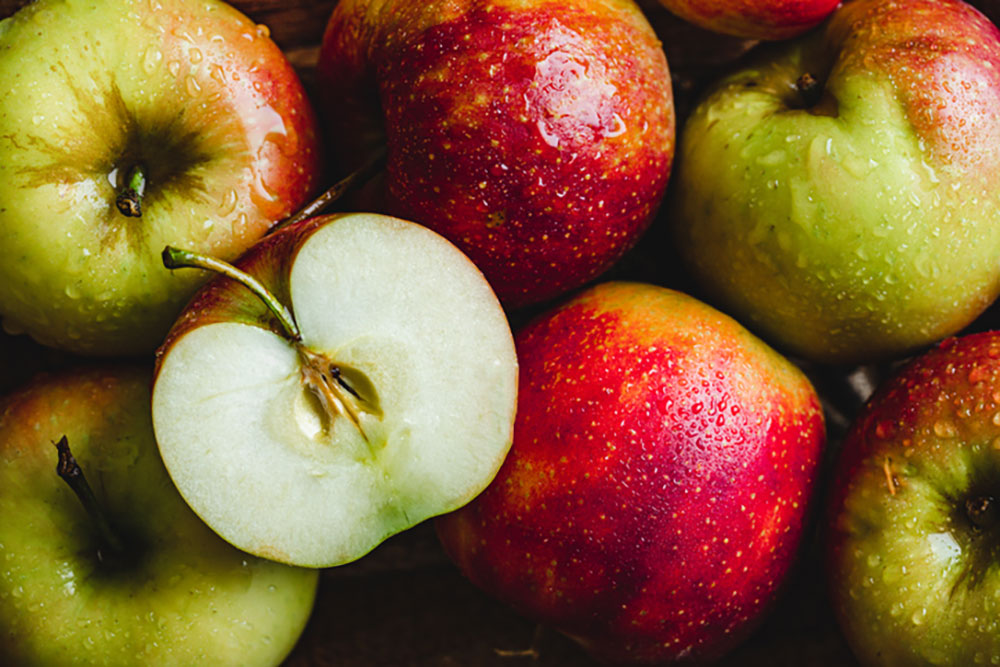As American as Apple Pie
 Actually, the apple is, like so many of our forebears, an immigrant. It is not a fruit native to the US or Canada but rather to the mountainous area of Kazakhstan, thousands of years before Sacha Baron Cohen made that country into a comedic byword. Through centuries of Eurasian migration, apples were then grown throughout Europe, and different varieties were propagated. The colonists in Jamestown brought some cuttings and planted them in their new stakehold in 1607. And the first record of a commercial apple orchard is in 1697, in Boston. But these apples were bitter and used for hard cider, as they were in England and France. As fermented cider was viewed as a preventative against pathogens, colonists and their children drank it with meals (watered down for the younger set). Thomas Jefferson was gifted some apple cuttings from a prominent French botanist. He grew the apple known as the Ralls Genet. The Ralls Genet was grafted by Japanese botanists in 1939 to the American Red Delicious apple. It is known to you and me as the Fuji.
Actually, the apple is, like so many of our forebears, an immigrant. It is not a fruit native to the US or Canada but rather to the mountainous area of Kazakhstan, thousands of years before Sacha Baron Cohen made that country into a comedic byword. Through centuries of Eurasian migration, apples were then grown throughout Europe, and different varieties were propagated. The colonists in Jamestown brought some cuttings and planted them in their new stakehold in 1607. And the first record of a commercial apple orchard is in 1697, in Boston. But these apples were bitter and used for hard cider, as they were in England and France. As fermented cider was viewed as a preventative against pathogens, colonists and their children drank it with meals (watered down for the younger set). Thomas Jefferson was gifted some apple cuttings from a prominent French botanist. He grew the apple known as the Ralls Genet. The Ralls Genet was grafted by Japanese botanists in 1939 to the American Red Delicious apple. It is known to you and me as the Fuji.

All Butter Crust (Double Version)
- 3 cups 320gr) all purpose flour
- 8 oz (226gr) unsalted butter, cubed and frozen for 20 minutes
- 2 pinches fine sea salt or kosher salt
- 1/2 cup (120ml) ice water
- Place your processor bowl on a scale set to zero and weigh in the flour. Cathy Barrow uses bleached flour, as it does not turn grayish when stored in the fridge.
- Weigh in the cubes of frozen butter. (I cut my butter frozen and then add.)
- Add the salt and insert the metal blade, cover, and pulse 15 times.
- Add the water all at once, process until the dough comes together in a rough ball.
- Cathy advises to lay down two sheets of plastic wrap to form an X, flour it lightly and dump your dough onto it, scraping up any extra pieces from your work bowl.
- With a scraper, form your dough into a ball. (I weigh out 2 halves, about 332gr each.)
- Roll each into a 4-inch diisk or a 3½-inch square and wrap.
- Once wrapped, roll each “package” of dough briefly and gently on each side.
- Put one wrapped dough ball in the freezer if you are not using it for baking now, but label the date. The one you’re going to use now needs to rest in the refrigerator at least 4 hours or overnight.

Alsatian Apple Tart
- 1 prepared tart crust about 10 inches (25cm) across (see recipe above)
- 3 or 4 small Golden Delicious apples
- Juice of ½ lemon
- ½ cup (115gr) white granulated sugar (I prefer India Tree Caster Sugar)
- ½ cup (120ml) heavy cream
- 1 egg
- 1 teaspoon Kirsch or, my preference, 1/8 teaspoon French Green Apple essence and 1 teaspoon Calvados
- Preheat oven to 375F and blind-bake* the crust in a short-sided metal tart pan with a removable bottom.
- Peel and core the apples and cut them into 8 slices each.
- Moisten the apple slices with the lemon juice and arrange them in a circular pattern in your pre-baked shell, still in the tart pan.
- Bake the tart for 20 minutes.
- While it is baking, mix the sugar, cream, egg and flavorings.
- When you have removed the tart from the oven, strain this mixture through a fine sieve over the tart.
- Return the tart to the oven and bake for an additional 25 to 35 minutes. The apples should be soft and the cream lightly set.
- Serve at room temperature.
- *Blind baking is baking a pie crust without the filling. To keep the crust from puffing up, place parchment paper across it and weigh the paper down with dried beans or pie weights.
- The tart keeps 2 days covered at room temperature. It will keep a couple of days longer in the refrigerator, but it should be reheated slightly for serving.
An American Icon Revisited
 As an adolescent, I whined incessantly to my mother to buy me the American toaster wonder, Pop Tarts. I mean, they
As an adolescent, I whined incessantly to my mother to buy me the American toaster wonder, Pop Tarts. I mean, they  had to be as good as Mounds Bars or Hostess Cupcakes! Reluctantly, she bought a pack. I popped them in our toaster with their no-melt icing (that should have been a warning), and the disappointing taste was my first lesson, but certainly not my last, in false marketing. You can use the All Butter Crust (above) and create this oh-so-superior version of Pop Tarts from Joanne Chang’s first book, Flour. She makes hers the size of a small index card; I make mine smaller. You can re-roll the scraps of this crust to eke out a few more. I find my pasta cutting tool (see photo, right) from August Thomsen invaluable for this and other precision cuts. Freeze the dough squares flat on a tray and then pop the pieces into a sealable freezer bag. Bake them frozen (you’ll have to add a few minutes to the baking time) and then frost them when they have cooled. I keep them covered at room temperature for 2 to 3 days.
had to be as good as Mounds Bars or Hostess Cupcakes! Reluctantly, she bought a pack. I popped them in our toaster with their no-melt icing (that should have been a warning), and the disappointing taste was my first lesson, but certainly not my last, in false marketing. You can use the All Butter Crust (above) and create this oh-so-superior version of Pop Tarts from Joanne Chang’s first book, Flour. She makes hers the size of a small index card; I make mine smaller. You can re-roll the scraps of this crust to eke out a few more. I find my pasta cutting tool (see photo, right) from August Thomsen invaluable for this and other precision cuts. Freeze the dough squares flat on a tray and then pop the pieces into a sealable freezer bag. Bake them frozen (you’ll have to add a few minutes to the baking time) and then frost them when they have cooled. I keep them covered at room temperature for 2 to 3 days.

Apple Pop Tarts
½ recipe of the All Butter Pie Crust, above
1 egg lightly beaten with a pinch of salt
For the filling
3 tablespoons (43gr) unsalted butter
2 apples peeled, cored, and sliced thin (Chang uses Granny Smith, I use Golden Delicious)
½ cup (110gr) Light Muscovado sugar (I use India Tree)
½ cup (70gr) white all-purpose flour
1 egg, lightly beaten, plus another for an egg wash
½ teaspoon ground cinnamon (Vietnamese cinnamon offers a more pungent flavor than others)
Pinch fine sea salt
1/8 teaspoon Green Apple Essence
For the glaze
1 cup (120gr) confectioner’s sugar (I use India Tree)
¼ teaspoon ground cinnamon
2 tablespoons Calvados or apple cider
Bare 1/8 teaspoon Green Apple Essence from Grasse
Instructions
Preheat oven to 350F.
In a medium saucepan, melt the butter over medium heat and add the apple slices. Lower the heat and cook the apples in the butter, stirring occasionally with a heat-resistant spatula for 2 to 3 minutes (the apples should be just soft). Add the sugar and continue to toss and stir for another 2 to 3 minutes (the sugar should be dissolved, and the apples should start to fall apart).
Remove from heat and transfer the mixture to a small bowl and allow to cool for about 20 minutes.
When cool, add the flour first and mix thoroughly. Then add the beaten egg, cinnamon, salt, and essence, if using. Make sure that all the ingredients are thoroughly incorporated. The mixture should have a jammy consistency and it must be cool when you start filling your pastry.
Roll out your pastry into rough rectangles or squares in the size you want. (I use an adjustable pasta/pastry cutter; see photo above.) Save the scraps from the edges as the scraps can be rerolled to make at least one or two more pastries.
Brush the pastry squares (or rectangles) with an egg wash (I have omitted this step occasionally, but it just ensures a seal, especially if you freeze the pastries). In the middle of half of the squares/rectangles, put about 1½ or 2 tablespoons of filling. If you have made rectangles, make the mound a bit longer than wide so that it follows the shape of the cut pastry.
Top each filled pastry piece with one of the plain pieces and crimp all four edges with a fork. Press the fork down firmly, especially on the corners.
Bake on a parchment or Silpat liner sheet for about 40 minutes. Crusts should be a light gold color.
Allow to cool completely on a rack before brushing on the glaze.
For the glaze
Mix the confectioner’s sugar and cinnamon with the Calvados or cider. Add the essence to taste.
Apply the glaze with an icing spatula or, if getting fancy, drizzle through a pastry bag with a small tip.
The tarts keep nicely at room temperature for 2 to 3 days if covered.
Glaze and filling can be kept covered in the refrigerator for a week. You can make the tarts ahead of time and freeze them without baking them or frosting them: Pop them into the oven and glaze when cooled.


 By Nancy Pollard
By Nancy Pollard

